-
 Bitcoin
Bitcoin $106,754.6083
1.33% -
 Ethereum
Ethereum $2,625.8249
3.80% -
 Tether USDt
Tether USDt $1.0001
-0.03% -
 XRP
XRP $2.1891
1.67% -
 BNB
BNB $654.5220
0.66% -
 Solana
Solana $156.9428
7.28% -
 USDC
USDC $0.9998
0.00% -
 Dogecoin
Dogecoin $0.1780
1.14% -
 TRON
TRON $0.2706
-0.16% -
 Cardano
Cardano $0.6470
2.77% -
 Hyperliquid
Hyperliquid $44.6467
10.24% -
 Sui
Sui $3.1128
3.86% -
 Bitcoin Cash
Bitcoin Cash $455.7646
3.00% -
 Chainlink
Chainlink $13.6858
4.08% -
 UNUS SED LEO
UNUS SED LEO $9.2682
0.21% -
 Avalanche
Avalanche $19.7433
3.79% -
 Stellar
Stellar $0.2616
1.64% -
 Toncoin
Toncoin $3.0222
2.19% -
 Shiba Inu
Shiba Inu $0.0...01220
1.49% -
 Hedera
Hedera $0.1580
2.75% -
 Litecoin
Litecoin $87.4964
2.29% -
 Polkadot
Polkadot $3.8958
3.05% -
 Ethena USDe
Ethena USDe $1.0000
-0.04% -
 Monero
Monero $317.2263
0.26% -
 Bitget Token
Bitget Token $4.5985
1.68% -
 Dai
Dai $0.9999
0.00% -
 Pepe
Pepe $0.0...01140
2.44% -
 Uniswap
Uniswap $7.6065
5.29% -
 Pi
Pi $0.6042
-2.00% -
 Aave
Aave $289.6343
6.02%
What does it mean when AR crosses BR in the ARBR indicator?
The ARBR indicator helps crypto traders spot potential trend reversals by tracking buying and selling pressure through its AR and BR components.
Jun 15, 2025 at 08:01 am
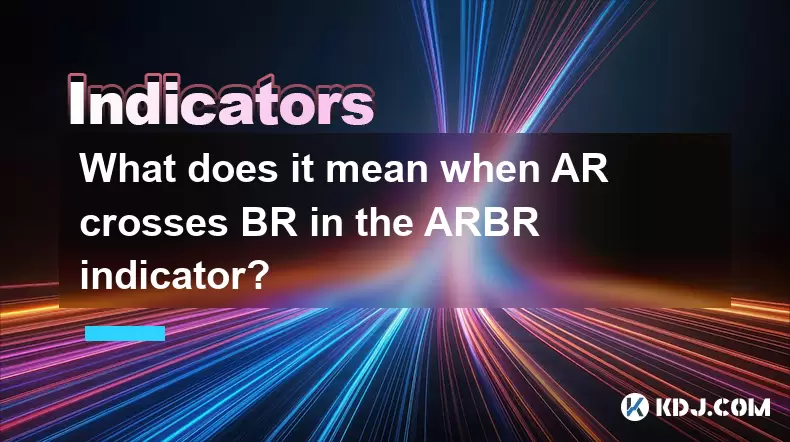
Understanding the ARBR Indicator
The ARBR indicator is a technical analysis tool commonly used in cryptocurrency trading to assess market sentiment and potential trend reversals. It consists of two components: the AR (Accumulation Ratio) and the BR (Balanced Ratio). The AR measures the strength of buying pressure over a specific period, typically 26 days, while the BR reflects the strength of selling pressure during the same time frame.
In practice, traders monitor both values as they oscillate around a central reference line, usually at the 100 level. When either value rises above or falls below this benchmark, it can signal bullish or bearish tendencies respectively. However, one of the most significant signals generated by this indicator occurs when the AR crosses BR, which may suggest an imminent shift in market momentum.
Important:
Understanding how each component reacts to price movements is crucial before interpreting their crossover.What Happens When AR Crosses BR?
When the AR crosses BR, it indicates a potential change in the prevailing trend. This crossover can occur in two directions: AR rising above BR or AR falling below BR. Each scenario provides different implications for traders analyzing crypto assets.
- If AR crosses above BR, it often suggests increasing accumulation and buyer dominance. This might be interpreted as a bullish signal, especially if it occurs after a prolonged downtrend.
- Conversely, if AR crosses below BR, it may point to intensifying distribution and seller control, potentially signaling a bearish reversal or continuation.
These crossovers are not foolproof and should always be confirmed with additional indicators or chart patterns to avoid false signals.
How to Interpret the ARBR Crossover in Crypto Markets
Cryptocurrency markets are known for their volatility, making it essential to interpret ARBR crossovers carefully. Here’s how you can break down the meaning of such events:
Look at the position of the crossover relative to the 100 baseline:
- A crossover above 100 where AR surpasses BR could indicate strong buying pressure and potential upward movement.
- A crossover below 100 where AR dips under BR might reflect weakening demand and possible downward movement.
Consider the volume and candlestick formations around the crossover:
- High volume accompanying the crossover increases its significance.
- Bullish or bearish candlestick patterns near the crossover area can reinforce the signal.
Examine historical behavior of the asset:
- Some cryptocurrencies respond more reliably to certain technical indicators than others.
- Backtesting previous crossovers on the same pair can help determine reliability.
Using the ARBR Crossover for Entry and Exit Signals
Traders often use the ARBR crossover as part of a broader strategy to time entries and exits. Here’s how you might incorporate this into your trading plan:
Entry Signal (Bullish):
- Wait for AR to cross above BR after a downtrend.
- Confirm with other tools like moving averages or RSI showing oversold conditions.
- Place a buy order slightly above the current price to catch the breakout.
Exit Signal (Bearish):
- Watch for AR to cross below BR following an uptrend.
- Check for signs of overbought levels using RSI or MACD divergence.
- Set a stop-loss just below recent swing lows to manage risk.
Risk management remains key:
- Always set clear stop-loss levels based on support/resistance zones.
- Avoid entering large positions solely based on a single indicator.
This approach works best when combined with sound money management principles and multi-indicator confirmation.
Common Misinterpretations and Pitfalls
Despite its usefulness, the ARBR indicator is sometimes misread, especially by novice traders. Here are some common mistakes and misunderstandings:
Assuming every crossover is a valid trade signal:
- Many crossovers occur during consolidation phases and do not lead to substantial moves.
- Filtering these with trendlines or volume spikes can reduce false positives.
Ignoring divergences between price and ARBR:
- If price makes a new high but AR fails to rise above BR significantly, it may indicate hidden weakness.
- Similarly, a new low in price without a corresponding drop in AR could hint at upcoming strength.
Overreliance on ARBR alone:
- No single indicator guarantees success.
- Combining ARBR with other tools like Bollinger Bands, Fibonacci retracements, or Ichimoku Clouds improves accuracy.
By being aware of these pitfalls, traders can better utilize the ARBR indicator without falling into traps that lead to poor decision-making.
Frequently Asked Questions (FAQ)
Q: Can the ARBR indicator be applied to all cryptocurrencies?
Yes, the ARBR indicator can be applied to any tradable cryptocurrency asset. However, its effectiveness may vary depending on the liquidity and volatility of the specific coin or token. Highly volatile or thinly traded assets may produce less reliable signals compared to major coins like Bitcoin or Ethereum.
Q: How often does the AR cross BR in typical crypto charts?
The frequency of AR crossing BR depends on the time frame being analyzed. On daily charts, it may happen once every few weeks, while on shorter time frames like 1-hour or 15-minute charts, it can occur multiple times per day. Traders should adjust their expectations and strategies accordingly.
Q: Is there a way to customize the ARBR indicator settings?
Most trading platforms allow customization of the default calculation period, which is usually set to 26 days. Adjusting the period can make the indicator more sensitive (shorter periods) or smoother (longer periods). However, changing the setting too drastically may reduce its predictive value.
Q: Should I combine the ARBR crossover with fundamental analysis?
While the ARBR crossover is purely a technical signal, combining it with fundamental insights—such as news about protocol upgrades, regulatory changes, or adoption trends—can enhance decision-making. Technical indicators work best alongside macro-level understanding in crypto trading.
Disclaimer:info@kdj.com
The information provided is not trading advice. kdj.com does not assume any responsibility for any investments made based on the information provided in this article. Cryptocurrencies are highly volatile and it is highly recommended that you invest with caution after thorough research!
If you believe that the content used on this website infringes your copyright, please contact us immediately (info@kdj.com) and we will delete it promptly.
- 2025-W Uncirculated American Gold Eagle and Dr. Vera Rubin Quarter Mark New Products
- 2025-06-13 06:25:13
- Ruvi AI (RVU) Leverages Blockchain and Artificial Intelligence to Disrupt Marketing, Entertainment, and Finance
- 2025-06-13 07:05:12
- H100 Group AB Raises 101 Million SEK (Approximately $10.6 Million) to Bolster Bitcoin Reserves
- 2025-06-13 06:25:13
- Galaxy Digital CEO Mike Novogratz Says Bitcoin Will Replace Gold and Go to $1,000,000
- 2025-06-13 06:45:13
- Trust Wallet Token (TWT) Price Drops 5.7% as RWA Integration Plans Ignite Excitement
- 2025-06-13 06:45:13
- Ethereum (ETH) Is in the Second Phase of a Three-Stage Market Cycle
- 2025-06-13 07:25:13
Related knowledge

How to set the stop profit point after the high-level propeller pattern?
Jun 16,2025 at 08:04pm
Understanding the High-Level Propeller PatternThe high-level propeller pattern is a technical analysis formation often observed in cryptocurrency trading charts. It typically appears at significant price peaks and signals potential reversals. The pattern consists of a large candlestick with long upper and lower shadows, resembling a propeller, indicatin...

When is the most reasonable stop loss after the three crows pattern?
Jun 16,2025 at 08:14pm
Understanding the Three Crows Pattern in Cryptocurrency TradingThe three crows pattern is a well-known bearish reversal signal in technical analysis, particularly relevant in volatile markets like cryptocurrency. It typically appears at the end of an uptrend and consists of three consecutive long red (or bearish) candles with progressively lower closes....
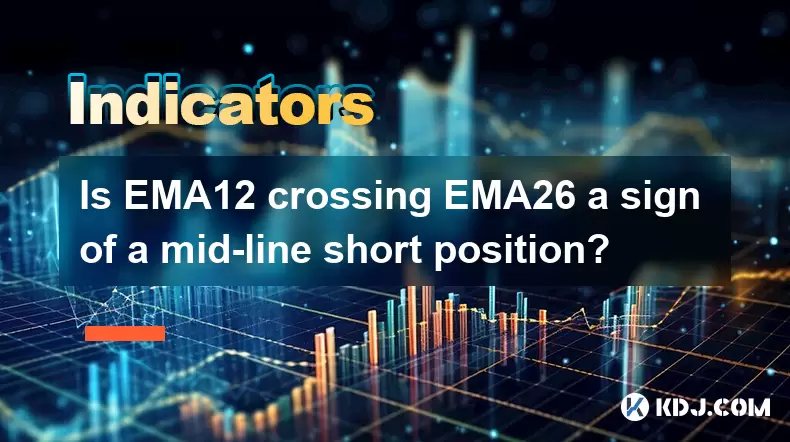
Is EMA12 crossing EMA26 a sign of a mid-line short position?
Jun 16,2025 at 07:22pm
Understanding EMA12 and EMA26 in Cryptocurrency TradingIn the world of cryptocurrency trading, Exponential Moving Averages (EMAs) are widely used tools for analyzing price trends. Specifically, the EMA12 and EMA26 are two of the most commonly referenced EMAs among traders. The EMA12 represents a short-term moving average calculated over the past 12 time...
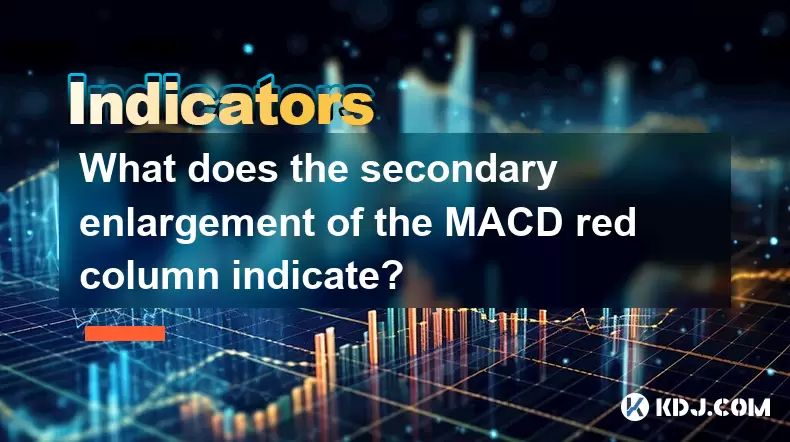
What does the secondary enlargement of the MACD red column indicate?
Jun 16,2025 at 07:49pm
Understanding the MACD Indicator and Its ComponentsThe Moving Average Convergence Divergence (MACD) is a widely used technical analysis tool in cryptocurrency trading. It consists of three main components: the MACD line, the signal line, and the MACD histogram. The histogram, represented as red or green bars, reflects the difference between the MACD lin...
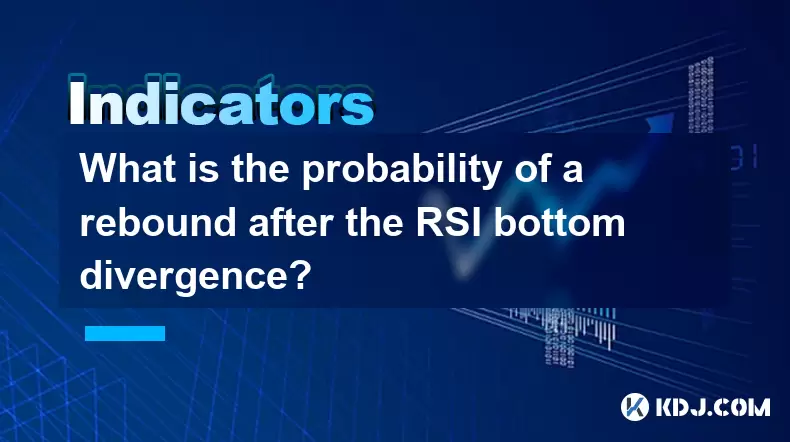
What is the probability of a rebound after the RSI bottom divergence?
Jun 16,2025 at 06:50pm
Understanding RSI Bottom Divergence in Cryptocurrency TradingThe Relative Strength Index (RSI) is a widely used momentum oscillator in technical analysis, particularly within the cryptocurrency market. It helps traders identify overbought or oversold conditions and potential reversal points. A bottom divergence occurs when the price of an asset makes a ...
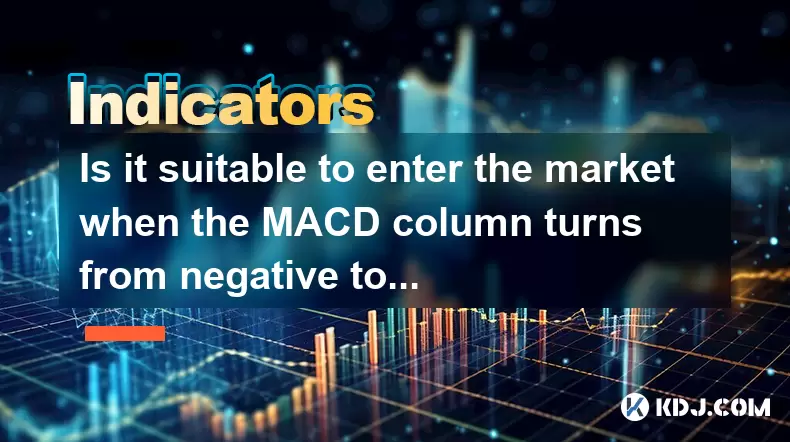
Is it suitable to enter the market when the MACD column turns from negative to positive?
Jun 16,2025 at 06:07pm
Understanding the MACD IndicatorThe Moving Average Convergence Divergence (MACD) is a widely used technical analysis tool in cryptocurrency trading. It consists of three main components: the MACD line, the signal line, and the MACD histogram (often referred to as the MACD column). The MACD line is calculated by subtracting the 26-period Exponential Movi...

How to set the stop profit point after the high-level propeller pattern?
Jun 16,2025 at 08:04pm
Understanding the High-Level Propeller PatternThe high-level propeller pattern is a technical analysis formation often observed in cryptocurrency trading charts. It typically appears at significant price peaks and signals potential reversals. The pattern consists of a large candlestick with long upper and lower shadows, resembling a propeller, indicatin...

When is the most reasonable stop loss after the three crows pattern?
Jun 16,2025 at 08:14pm
Understanding the Three Crows Pattern in Cryptocurrency TradingThe three crows pattern is a well-known bearish reversal signal in technical analysis, particularly relevant in volatile markets like cryptocurrency. It typically appears at the end of an uptrend and consists of three consecutive long red (or bearish) candles with progressively lower closes....

Is EMA12 crossing EMA26 a sign of a mid-line short position?
Jun 16,2025 at 07:22pm
Understanding EMA12 and EMA26 in Cryptocurrency TradingIn the world of cryptocurrency trading, Exponential Moving Averages (EMAs) are widely used tools for analyzing price trends. Specifically, the EMA12 and EMA26 are two of the most commonly referenced EMAs among traders. The EMA12 represents a short-term moving average calculated over the past 12 time...

What does the secondary enlargement of the MACD red column indicate?
Jun 16,2025 at 07:49pm
Understanding the MACD Indicator and Its ComponentsThe Moving Average Convergence Divergence (MACD) is a widely used technical analysis tool in cryptocurrency trading. It consists of three main components: the MACD line, the signal line, and the MACD histogram. The histogram, represented as red or green bars, reflects the difference between the MACD lin...

What is the probability of a rebound after the RSI bottom divergence?
Jun 16,2025 at 06:50pm
Understanding RSI Bottom Divergence in Cryptocurrency TradingThe Relative Strength Index (RSI) is a widely used momentum oscillator in technical analysis, particularly within the cryptocurrency market. It helps traders identify overbought or oversold conditions and potential reversal points. A bottom divergence occurs when the price of an asset makes a ...

Is it suitable to enter the market when the MACD column turns from negative to positive?
Jun 16,2025 at 06:07pm
Understanding the MACD IndicatorThe Moving Average Convergence Divergence (MACD) is a widely used technical analysis tool in cryptocurrency trading. It consists of three main components: the MACD line, the signal line, and the MACD histogram (often referred to as the MACD column). The MACD line is calculated by subtracting the 26-period Exponential Movi...
See all articles

























































































